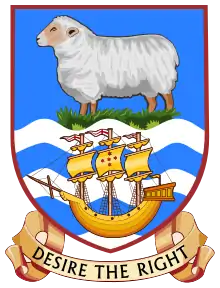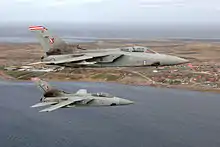No. 1435 Flight RAF
No. 1435 Flight is a Typhoon FGR. 4 unit of the Royal Air Force, based at RAF Mount Pleasant, providing air defence for the Falkland Islands, South Georgia and the South Sandwich Islands.
| No. 1435 Flight RAF | |
|---|---|
 | |
| Active | 4 Dec 1941 – Jun 1942 15 Jul 1942 – 2 Aug 1942 late 1983 - May 1985 1 Nov 1988 – present[1] |
| Country | |
| Branch | |
| Type | Flying unit |
| Role | Air defence |
| Size | Four aircraft |
| Part of | British Forces South Atlantic Islands |
| Home station | RAF Mount Pleasant |
| Motto(s) | Protect the right |
| Aircraft | Eurofighter Typhoon FGR4 |
| Insignia | |
| Squadron tail and nose badges |   |
| Squadron Codes | F, H, C and D |
During the Second World War, No. 1435 Flight was a night fighter unit on Malta, subsequently raised to squadron status, becoming the only RAF flying squadron to be given a four digit number.[2][3]
History
Early years
No. 1435 (Night Fighter) Flight was first formed at Malta as a night fighter unit on 4 December 1941, by re-designating the Malta Night Fighter Unit.[1] In July 1942, personnel from No. 603 Squadron were equipped with the Spitfire V to form the unit.[2] After a brief period as No.1435 (Fighter) Flight, at RAF Luqa, due to its size it was raised to No. 1435 Squadron on 2 August 1942 at RAF Luqa, Malta[4][5]
It converted to fighter-bomber activities in January 1943 and operated over Sicily and in Italy. It was assigned to the Balkan Air Force, carrying out operations over Albania and Yugoslavia until the end of the war.
It disbanded on 29 April 1945 at Falconara, Italy.[6]
Falkland Islands


Following the Falklands War, the Flight provided an air defence unit at Stanley airfield. As this was badly damaged during the fighting the Flight reformed with Hawker Siddeley Harrier GR.3 aircraft in late 1983 and disbanding again in May 1985.
In November 1988, when 23 Squadron converted to the Tornado, 1435 Flight was revived, equipped with four McDonnell Douglas Phantom FGR.2s. After No. 23 Squadron's disbandment at RAF Mount Pleasant, the mission and equipment were transferred to No. 1435 Flight. The Phantoms were replaced in July 1992 when four Panavia Tornado F3 arrived in the Falklands.[7] The flight was later re-equipped with the Eurofighter Typhoon.
The aircraft are permanently based in the islands, as told by CPO(AWT) Edwards, while the aircrew from the UK are cycled through No. 1435 Flight. While there they provide a 365-day, 24-hour alert.
Flight home stations
- RAF Ta Kali
- RAF Luqa (1942)
- RAF Stanley (1983 -1985)
- RAF Mount Pleasant (1988 – present)[1]
Aircraft operated
Aircraft operated by No. 1435 Flight.[1][5][8][9]
- Hawker Hurricane Mk.IIb / Mk.IIc (December 1941 – June 1942)
- Bristol Beaufighter Mk.I (August 1942 – April 1945)
- Hawker Siddeley Harrier GR.3 (1983 – 1985)
- McDonnell Douglas F-4 Phantom FGR.2 (November 1988 – 1992)
- Panavia Tornado F3 (1992 – September 2009)
- Eurofighter Typhoon FGR4 (September 2009 – present)
Heritage and traditions
Motto
The Flight goes by the motto of "Protect the Right" while the motto of the Falkland Islands is "Desire the Right".[lower-roman 1]
Maltese heritage
The Flight has maintained its Maltese connections, with its aircraft sporting the Maltese cross. The practice of naming the four-aircraft presence on the islands has also been maintained: they are called Faith, Hope and Charity, after the legendary three Gloster Sea Gladiators that once defended Malta, and Desperation. Desperation was added to the three traditional names when Phantoms entered service in the Falklands and the flight was revived in 1988. Faith, Hope and Charity fly operationally, with Desperation appropriately in reserve. On their retirement in 1992, one of the Phantoms was placed as the gate guardian at Mount Pleasant. The Phantoms were replaced by four Tornado F.3s. The four Tornados remained in active service until they were replaced in their turn by four Eurofighter Typhoon FGR4s in September 2009.[11] Although the unit's new aircraft do not have the traditional names applied, the four aircraft have tailcodes that match (F, H, C, D).[12]
See also
- No. 1312 Flight RAF - Falklands transport aircraft
- List of Royal Air Force aircraft squadrons
- List of Royal Air Force independent flights
- Military of the Falkland Islands
References
- Notes
- The WWII squadron had neither motto nor badge at that time.[10]
- Citations
- Lake (1999), p. ??
- Air of Authority – A History of RAF Organisation (RAFWEB). "No 671 – 1435 Squadron Histories".
- "No.1435 Squadron". RAF Museum Cold War Exhibition.
- Rawlings (1976), p. 511.
- Halley (1988), p. 459.
- Rawlings (1976), p. 512.
- March, Peter R. (1998). Brace by Wire to Fly-By-Wire – 80 Years of the Royal Air Force 1918–1998. RAF Fairford: Royal Air Force Benevolent Fund Enterprises. p. 158. ISBN 1-899808-06-X.
- Jefford (2001), p. 106.
- "No.1435 Squadron". National Cold War Exhibition. 2013. Retrieved 5 April 2018.
- "History of 1435 Squadron". MOD. Archived from the original on 22 December 2015. Retrieved 18 December 2015.
- Typhoons arrive in Falklands Archived 23 February 2010 at the Wayback Machine
- "News Brief". Air Forces Monthly (324): 7. January 2016.
- Bibliography
- Flintham, Vic; Thomas, Andrew (2003). Combat Codes: A full explanation and listing of British, Commonwealth and Allied air force unit codes since 1938. Shrewsbury, Shropshire: Airlife Publishing. ISBN 1-84037-281-8.
- Halley, James J. (1988). The Squadrons of the Royal Air Force & Commonwealth 1918–1988. Tonbridge, Kent: Air Britain (Historians). ISBN 0-85130-164-9.
- Jefford, C.G. (2001) [1988]. RAF Squadrons, a Comprehensive record of the Movement and Equipment of all RAF Squadrons and their Antecedents since 1912 (2nd ed.). Shrewsbury, Shropshire: Airlife Publishing. ISBN 1-85310-053-6.
- Lake, Alan (1999). Flying Units of the RAF. Shrewsbury, Shropshire: Airlife Publishing. ISBN 1-84037-086-6.
- Rawlings, John D.R. (1969). Fighter Squadrons of the RAF and their Aircraft ((2nd edition 1976, reprinted 1978) ed.). London: Macdonald & Jane's. ISBN 0-354-01028-X.
External links
| Wikimedia Commons has media related to No. 1435 Flight RAF. |
- Page of Images of 1435 Flight's Tornado F.3s
- "FLIGHT 1435" Music video made by 1435 Flight personnel on YouTube, uploaded 18 January 2007.
